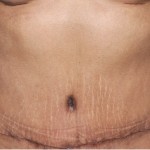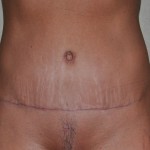Ever since the 1950s and the beginning of the evolution of the modern day tummy tuck, the search for techniques that produce a natural looking umbilicus have been both varied and different amongst many plastic surgeons. Everyone recognizes that complete loss of the umbilicus is associated with emotional disturbance in most patients even though it serves no medical function other than being recognized as being human.
The techniques for umbilical reconstruction (umbilicoplasty) are varied but most, historically, focus on preserving the original umbilical stalk. Known as umbilical translocation, the original stalk is preserved and then brought back through a new position on the abdominal skin. While the abdominal skin has been lowered, the new umbilical position is actually the same as the old one based on its original horizontal and vertical axis location. This creates a fine line scar around the skin on the outside but it really is the same umbilical stalk and in exactly the same position. It may have been shortened and reshaped but it is the original umbilicus.



The umbilicoplasty part of a tummy tuck, while the smallest step in the overall operation, is given great significance for most patients because it is more visible than the lower tummy tuck scar. Most umbilicoplasties are performed by a translocation technique rather than a reconstructive one. Umbilical reconstruction is more effective at avoiding visible and hypertrophic scars and obvious pigmentation differences between the remaining umbilical stalk and the outer abdominal skin. Pulling abdominal skin inward to create the new umbilicus avoids all the problems of the translocation technique with the creation of sufficient depth and some amount of superior hooding.
Dr. Barry Eppley
Indianapolis, Indiana


